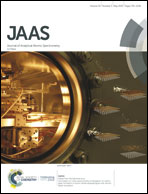Precise magnesium isotope analyses of high-K and low-Mg rocks by MC-ICP-MS†
Abstract
This study presents a chemical protocol for the separation of Mg that is particularly adapted for diverse igneous rock samples, especially for high-K and low-Mg rocks. This protocol is based on a combination of three procedures: the removal of K from the samples using the precipitation procedure, followed by the separation of Fe and Ca using 2 mL of AG50W-X12 cation exchange resin, and finally the removal of Al, Ti, Na, and Fe elements using 0.5 mL of AG50W-X12 cation exchange resin. The effect of acidity and concentration mismatch as well as the matrix effect were rigorously evaluated using Nu Plasma II MC-ICP-MS with a wet plasma mode. The δ26Mg mean values of the GSB and Alfa Mg standard solutions are −2.05 ± 0.05‰ (2 standard deviation (2s), n = 106) and −3.91 ± 0.04‰ (2s, n = 51), respectively, which serve as in-house Mg standards in the State Key Laboratory of Continental Dynamics (SKLCD). The average δ26Mg value of one multi-elemental Mg standard GSB-1, made by adopting GSB with matrix elements, agrees well with the recommended value after precipitation and chromatographic separation. The long-term reproducibility, assessed by repeated measurements of Mg standard solutions and reference materials (RMs), is ±0.06‰. The robustness of our method is further assessed by the replicated analyses of fifteen rock standards and olivine grains with large variations in MgO and K2O content.



 Please wait while we load your content...
Please wait while we load your content...